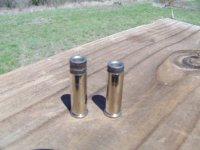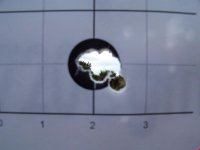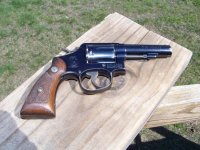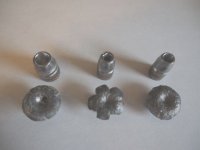I've read, here and there, about seating Speer HBWC backwards to create a hollow-point that would expand at lower velocities, uniformly, regardless of plugging with clothing, etc. Thought I'd experiment a bit. I loaded 12 each .38 Special rounds with Speer 148 grain HBWC seated backwards to the first cannelure and the second cannelure. Brass was nickle-plated R-P, primers were CCI, powder was Bullseye, and the charge was 3.7 grains. Modest crimp.
I am NOT recommending anyone try this, or any other, load.
The results were interesting if a bit predictable. The deeper-seated bullets chronographed at 748 fps with an extreme spread of 18. The bullets seated further out had an average velocity of 726 with an extreme spread of 32 (a little less pressure - a little less velocity). The bullets seated deeper, at essentially the same depth as a WC seated properly, made more ragged holes and may have entered the target, 25 feet away, slightly cattywampus. The bullets seated out, though slightly slower and with a slightly larger extreme spread, drilled wadcutter-style, nice round, holes. In fact something happened that doesn't happen to me very often; they went into one (ragged) hole (the second six shots).
All shots were assisted with a Caldwell adjustable pistol rest from a bench. I made no attempt to check expansion of the bullets as this was just to see how they'd behave accuracy-wise. And yes, though the photo doesn't show it, I had a solid and reliable backstop.
After 24 rounds of these loads, 12 of each seating depth, I packed it up. When giving the S&W Model 10-6 a cleaning I discovered what I would call a lot of leading in the barrel. It was a pain, and then some, to clean out. The more I thought, the more it seemed to make sense, as the hollow-base on this Speer is "supposed" to flare a bit helping form a gas seal. As is was seated backwards obviously that wasn't going to work. The lube on these bullets seems very light as well, though I understand Speer uses a proprietary "dry" lube that is claimed to work well, and I can't argue with that as I've not experienced this level of leading with these same bullets loaded properly.
Has anyone else experienced this? The leading problem was not mentioned in any of the gun press articles I read that got me interested in trying this particular activity. Does the logic of putting the hollow-base in front make sense for increased lead deposits in the bore? I like this Model 10 and don't want to wear it out cleaning it. Not planning on making a habit of this practice but I'd like to do some wet newsprint expansion tests but already not looking forward to the cleanup. BYW; Hoppes #9, patience, a copper wool wrapped brush, and more patience, did the trick - and the bore was nice an shiny when I began this endeavor.
I am NOT recommending anyone try this, or any other, load.
The results were interesting if a bit predictable. The deeper-seated bullets chronographed at 748 fps with an extreme spread of 18. The bullets seated further out had an average velocity of 726 with an extreme spread of 32 (a little less pressure - a little less velocity). The bullets seated deeper, at essentially the same depth as a WC seated properly, made more ragged holes and may have entered the target, 25 feet away, slightly cattywampus. The bullets seated out, though slightly slower and with a slightly larger extreme spread, drilled wadcutter-style, nice round, holes. In fact something happened that doesn't happen to me very often; they went into one (ragged) hole (the second six shots).
All shots were assisted with a Caldwell adjustable pistol rest from a bench. I made no attempt to check expansion of the bullets as this was just to see how they'd behave accuracy-wise. And yes, though the photo doesn't show it, I had a solid and reliable backstop.
After 24 rounds of these loads, 12 of each seating depth, I packed it up. When giving the S&W Model 10-6 a cleaning I discovered what I would call a lot of leading in the barrel. It was a pain, and then some, to clean out. The more I thought, the more it seemed to make sense, as the hollow-base on this Speer is "supposed" to flare a bit helping form a gas seal. As is was seated backwards obviously that wasn't going to work. The lube on these bullets seems very light as well, though I understand Speer uses a proprietary "dry" lube that is claimed to work well, and I can't argue with that as I've not experienced this level of leading with these same bullets loaded properly.
Has anyone else experienced this? The leading problem was not mentioned in any of the gun press articles I read that got me interested in trying this particular activity. Does the logic of putting the hollow-base in front make sense for increased lead deposits in the bore? I like this Model 10 and don't want to wear it out cleaning it. Not planning on making a habit of this practice but I'd like to do some wet newsprint expansion tests but already not looking forward to the cleanup. BYW; Hoppes #9, patience, a copper wool wrapped brush, and more patience, did the trick - and the bore was nice an shiny when I began this endeavor.






